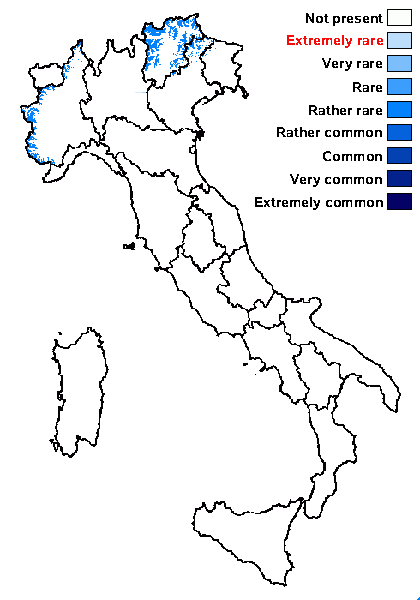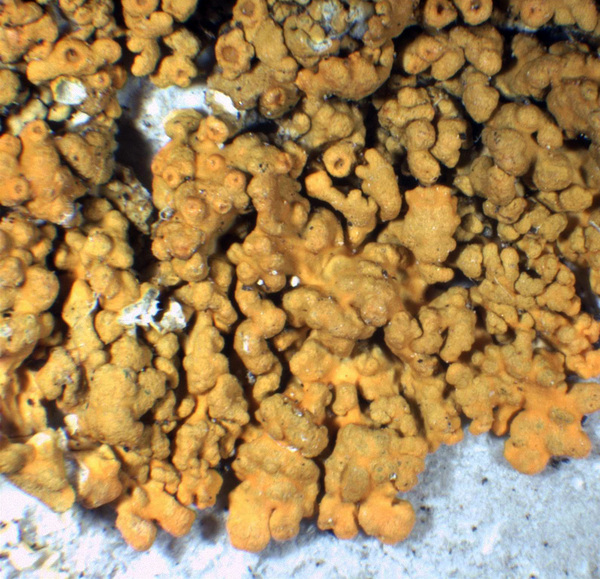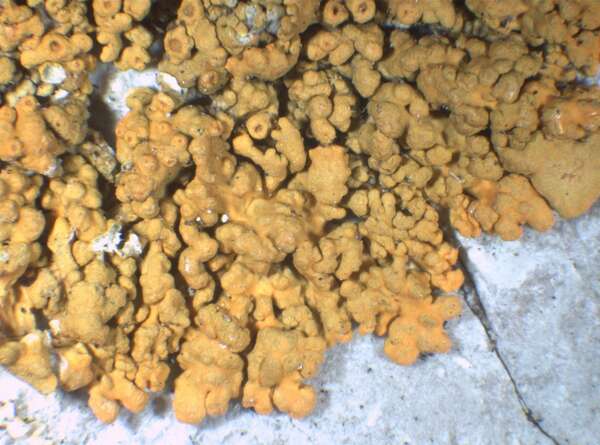Rusavskia elegans (Link) S.Y. Kondr. & Kärnefelt subsp. orbicularis (Schaer.)
Provisionally placed here, ICN Art. 36.1b.. Basionym: Parmelia elegans var. orbicularis Schaer. - Enum. Crit. Lich. Eur.: 51, 1850.
Synonyms: Xanthoria elegans subsp. orbicularis (Schaer.) Clauzade & Cl. Roux
Distribution: N - Frl (vidi!), Ven (Nimis 1994), TAA, Piem (Morisi & Sereno 1995).
Description: Thallus foliose, heteromerous, dorsiventral, tightly adnate, orange-yellow, deep orange to orange-red, forming up to 6 cm wide rosettes, the central parts often dying off in old thalli. Lobes flat, broader and 2-3 mm wide at apex, discrete for much of their length, usually short and not markedly sinuous, emaculate; lower surface white, rarely with very short, white hapters. Upper and lower cortex mesodermate paraplectenchymatous; medulla white. Apothecia common, lecanorine/zeorine, laminal, substipitate, up to 2 mm across, orange to orange-red. Epithecium orange-brown, K+ purple-red; hymenium colourless; paraphyses simple or sparingly branched, septate, swollen at tips; hypothecium colourless to pale brown. Asci 8-spored, clavate, functionally unitunicate, apically thickened with a broad internal beak, the inner part of apex and external cap I+ blue, Teloschistes-type. Ascospores 2-celled, polarilocular, hyaline, ellipsoid, 9-18 x 5-9 µm, the equatorial thickening (“septum”) 3-5 µm. Photobiont chlorococcoid. Spot tests: upper surface K+ purple-red, C-, KC-, P-, UV+ intensely orange-red. Chemistry: thallus and apothecia with parietin (major), fallacinal, emodin, teloschistin and parietinic acid (minor), corresponding with chemosyndrome A of Søchting (1997).Note: this taxon, which is most frequent in the Alps near treeline, needs further study: it might prove to be unrelated to the typical subspecies.
Growth form: Foliose, narrow lobed
Substrata: rocks
Photobiont: green algae other than Trentepohlia
Reproductive strategy: mainly sexual
Poorly known taxon in need of further study
Commonnes-rarity: (info)
Alpine belt: extremely rare
Subalpine belt: rather rare
Oromediterranean belt: absent
Montane belt: very rare
Submediterranean belt: absent
Padanian area: absent
Humid submediterranean belt: absent
Humid mediterranean belt: absent
Dry mediterranean belt: absent

Predictive model
Herbarium samples
Growth form: Foliose, narrow lobed
Substrata: rocks
Photobiont: green algae other than Trentepohlia
Reproductive strategy: mainly sexual
Poorly known taxon in need of further study
Commonnes-rarity: (info)
Alpine belt: extremely rare
Subalpine belt: rather rare
Oromediterranean belt: absent
Montane belt: very rare
Submediterranean belt: absent
Padanian area: absent
Humid submediterranean belt: absent
Humid mediterranean belt: absent
Dry mediterranean belt: absent

Predictive model
| Herbarium samples |
 DOLICHENS
DOLICHENS




